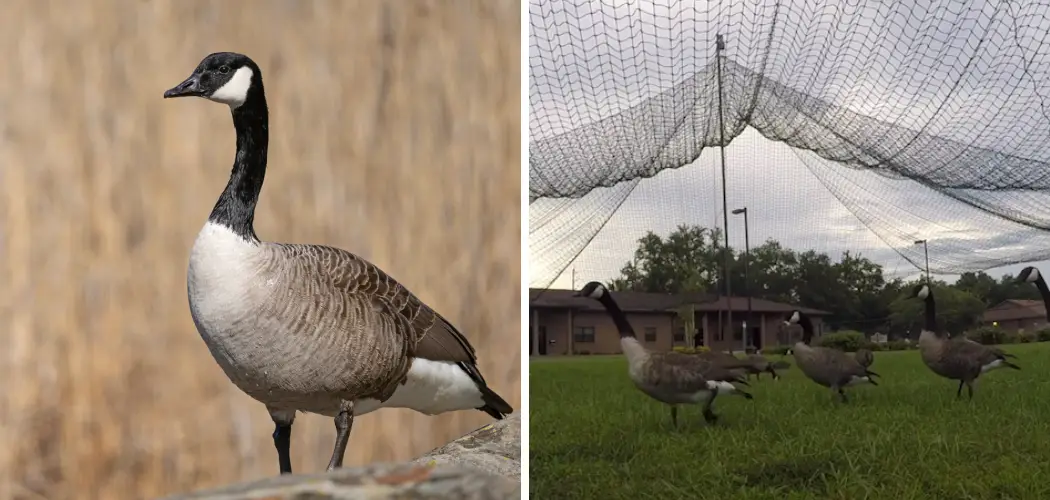The practice of goose trapping, a method intricately designed to manage populations and mitigate the challenges posed by nuisance geese, requires a blend of expertise, patience, and ethical consideration.
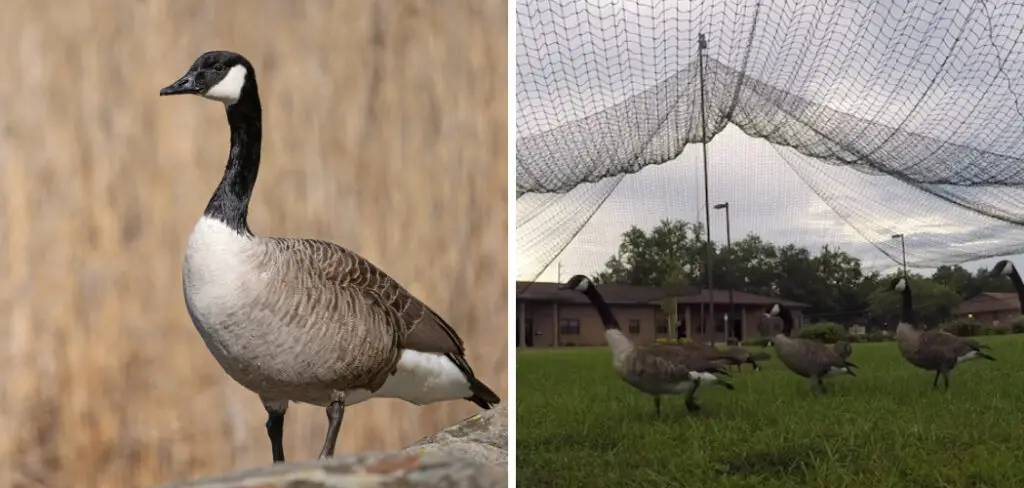
This guide aims to give readers a comprehensive understanding of how to trap a goose effectively while ensuring the humane treatment of these birds.
Trapping is often necessitated by addressing property damage, agricultural loss, and the public health concerns attributed to overpopulated goose communities.
By elucidating the various techniques and ethical considerations involved in goose trapping, this introduction sets the stage for a deeper exploration into selecting the right traps, baiting strategies, and maintaining the welfare of the trapped geese. The ultimate goal is to equip you with the knowledge to responsibly manage goose populations, mitigating human-wildlife conflicts with an emphasis on conservation and respect for natural wildlife behaviors.
Selecting the Right Trap
When considering how to trap a goose, selecting the right trap is paramount to ensuring not only the success of the capture but also the humane treatment of the animal. This section will cover the essential aspects of choosing the appropriate trap, focusing on live traps, their size and design, and the importance of strategic placement.
A. Live Traps
Opting for live traps specifically designed for capturing waterfowl is crucial. These traps ensure the geese’s humane capture and safe handling, minimizing stress and potential injury. Live traps work by enticing the goose into an enclosure from which it cannot escape until released. The trap mechanism must be smooth and reliable to prevent harm to the bird during capture and confinement.
B. Size and Design
The size and design of the trap should be chosen carefully to accommodate the size and behavior of the targeted goose species. Larger species require bigger traps to comfortably contain the bird without risk of injury.
Similarly, the trap design should consider the natural behavior of geese; for instance, traps that mimic the appearance of safe feeding grounds or resting areas are more likely to be successful. Features that allow for easy insertion of food and water without opening the trap are also beneficial for maintaining the well-being of the captured goose.
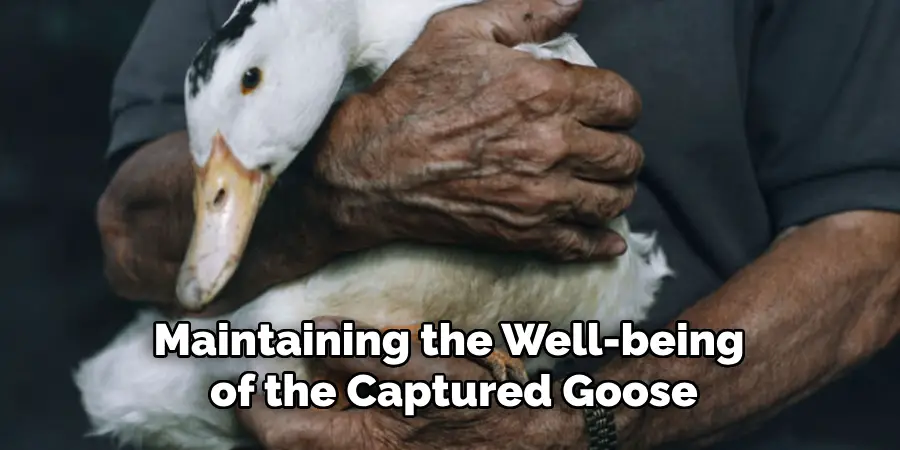
C. Placement Considerations
The placement of the trap is equally important and should be informed by a thorough understanding of environmental factors and goose behavior. Ideal locations are near water sources or favorite feeding areas where geese are known to congregate.
Visibility is a key factor; the trap should be placed in an area frequented by geese but not so conspicuous as to deter them. Also, consider the direction of prevailing winds and sun position to make the trap more inviting. Careful observation of the geese’s patterns and preferences will inform the best positions for trap placement, significantly increasing the likelihood of successful capture.
How to Trap a Goose: Baiting the Trap
Successfully trapping a goose involves not just selecting and placing the right trap but also effectively baiting it. The goal is to entice geese into the trap without arousing their suspicions, using bait that mimics their natural food sources or attracts them through artificial lures. This section explores the types of bait that can be used, offering strategies to increase the likelihood of capturing geese.
A. Natural Food Sources
The most effective way to bait a trap is by using food that geese naturally consume. Grains, such as corn or wheat, are highly attractive to geese and can be used effectively as bait. Additionally, green vegetation or grasses, which comprise a significant portion of a goose’s diet, can be placed inside the trap. It’s important to use fresh bait and replenish it regularly to keep it appealing. Natural food sources will attract geese and reduce captivity’s stress by providing them with familiar foods.
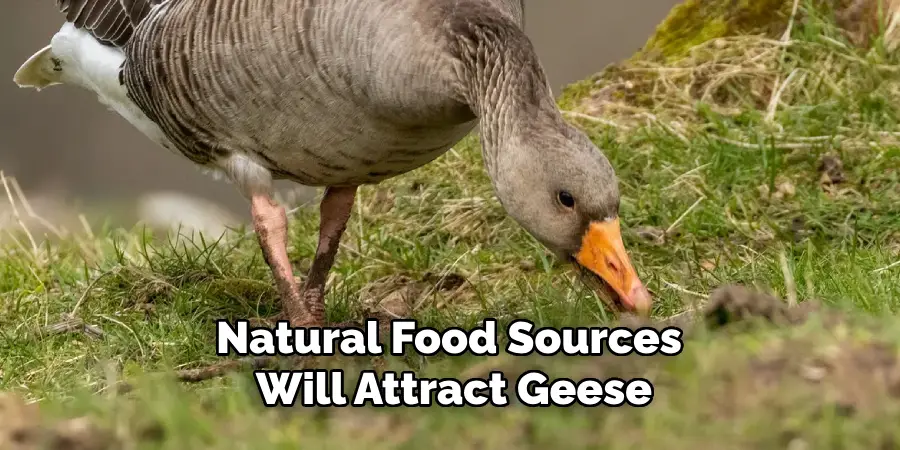
B. Artificial Lures
In some situations, commercially available goose lures or attractants can be used as bait. These products are specifically designed to mimic the scent or appearance of foods attractive to geese. While artificial lures can be effective, they should be used as a complement to natural food sources rather than as a replacement. Selecting lures that are environmentally safe and non-toxic to wildlife is crucial.
C. Placement and Timing
The strategic placement of bait within the trap is critical. Bait should be spread to encourage geese to fully enter the trap, ensuring that they trigger the mechanism to close the trap door. It’s also beneficial to place a trail of bait leading up to the trap, making the entrance more inviting. Observing the geese’s daily activity patterns can provide insights into the optimal times for baiting the trap.
Early morning or late afternoon, when geese are most actively searching for food, are typically the best times to lure them in.
Understanding and implementing these baiting strategies can significantly enhance your chances of trapping geese. Keep in mind that patience and observation are key. Regularly monitoring the trap and adjusting your approach based on what you learn about the local geese population will improve your success rate in humane goose trapping and management.
How to Trap a Goose: Setting Up the Trap
Setting up a trap for geese involves careful consideration of various factors to ensure its efficacy and the geese’s well-being. Below, we break down the critical steps in effectively setting up the trap.
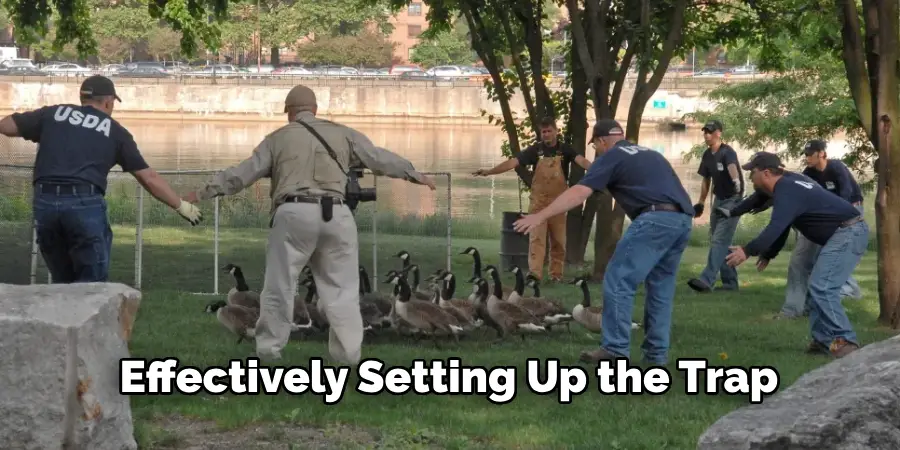
A. Location Selection
The choice of location is pivotal in trapping geese. Prioritize areas near water bodies or where geese are known to feed, as these are spots they frequent daily. Geese have specific patterns and tend to return to places where they feel safe and have found food previously. Observing the geese over a period to identify these locations can greatly increase the success rate of trapping.
B. Concealment
After selecting the optimal location, the next step is to ensure the geese cannot easily detect the trap. Use natural materials such as branches, leaves, or vegetation found in the surroundings to camouflage the trap. This makes the trap appear as part of the natural environment, significantly reducing the geese’s wariness towards it. Proper concealment is crucial to prevent the geese from being spooked away.
C. Pre-Baiting
An effective strategy to increase the likelihood of capturing geese is pre-baiting. This involves placing bait around and inside the trap without actually setting it. The idea is to allow geese to enter and leave the trap freely, getting accustomed to it as a safe place to find food. After several days of pre-baiting, when the geese have become familiar with the trap, it can then be set to capture them.
D. Proper Trap Placement
Ensuring the trap is placed on stable ground is essential to prevent it from tipping over or shifting, which could either scare off the geese or result in an unsuccessful capture. Check that the trap is securely anchored to the ground to withstand the weight of the geese and any environmental elements like wind. Additionally, ensure the trap door mechanism is clear of debris and can close smoothly, allowing for effective capture without harming the animal.
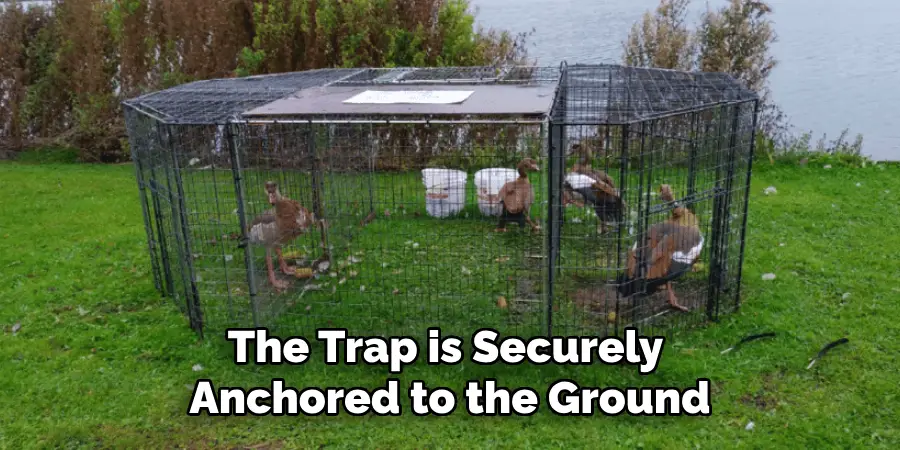
By meticulously following these guidelines—choosing a prime location, concealing the trap, pre-baiting to acclimate the geese, and ensuring stable and secure trap placement—you can significantly enhance your success in humane goose trapping. Remember, the goal is to manage geese populations in a safe and respectful way to the animals and the environment.
Monitoring and Maintenance
Consistent monitoring and maintenance after setting up the trap are crucial for the success of humane goose-trapping efforts. These steps ensure the captured geese’s well-being and the trap’s longevity.
A. Regular Surveillance
Regularly checking the trap is fundamental to humane trapping practices. This allows for the timely release or transfer of captured geese and helps assess the trap’s effectiveness and any potential issues with its mechanism. Ideally, the trap should be checked at least twice daily, in the morning and late afternoon.
This frequency ensures that any captured geese do not remain in the trap for extended periods, reducing stress and potential harm. Timely checks also provide insights into the daily patterns of goose activity, helping to refine trapping strategies over time.
B. Health and Safety Considerations
When handling captured geese, it’s imperative to prioritize their health and safety. This involves using proper handling techniques to minimize stress and prevent injury to both the geese and the handler. Handlers should wear suitable protective gear, such as gloves, to protect themselves and the animals.
Captured geese should be gently removed from the trap, keeping a firm yet careful grip to avoid harm. Understanding and recognizing signs of stress in geese can guide handlers in managing their behavior calmly and effectively. Additionally, suppose the goal is to transfer the captured geese. In that case, it’s important to have a suitable transportation plan in place that considers the comfort and safety of the geese during the move.
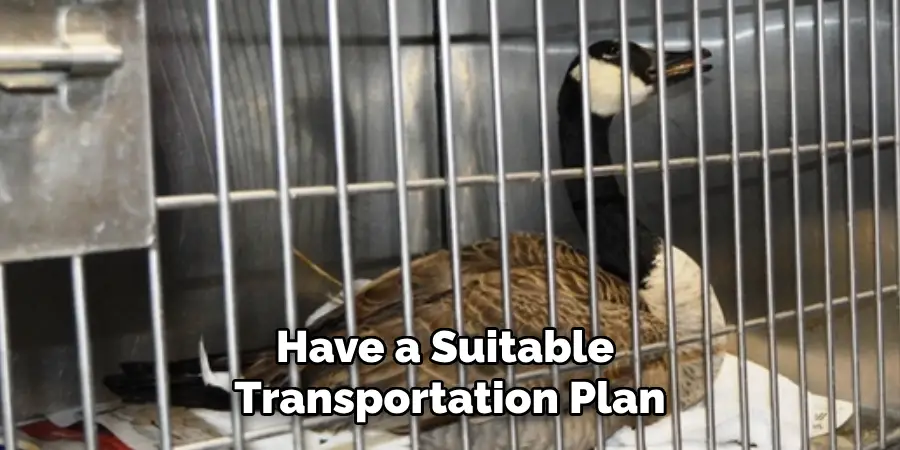
C. Trap Maintenance
Regular maintenance is necessary to ensure the trap continues to function as intended. This includes cleaning the trap after each capture to maintain a hygienic environment for both the geese and any future captures. Checking for and repairing any damage or wear to the trap can prevent malfunctions that could harm the geese or lead to unsuccessful captures. Proper maintenance also involves verifying that the trap mechanism operates smoothly and efficiently each time it is set.
Ensuring the trap stays in optimal condition through regular upkeep will extend its longevity and effectiveness in humane goose management efforts.
By adhering to these guidelines for monitoring and maintenance, individuals can conduct humane goose trapping ethically, effectively, and responsibly. This approach not only aids in managing goose populations but also ensures the safety and well-being of the birds during the process.
Ethical Considerations
Ethical considerations form the backbone of humane goose trapping and management. Ensuring that these practices do not harm the geese or disrupt the ecosystem requires adherence to several key principles.
A. Respect Wildlife Regulations
Before setting up any traps, it is paramount to be fully aware of and comply with all local, state, and federal regulations concerning goose trapping and wildlife management. These laws are designed to protect wildlife populations and their habitats while balancing the needs of human communities.
Ignorance of these regulations can lead to unintended harm to the geese, legal ramifications for the trapper, and potential disruptions to local ecosystems. Therefore, obtaining the necessary permits and understanding the legal framework is a critical first step in any ethical wildlife trapping endeavor.
B. Humane Treatment
The humane treatment of captured geese is not just a legal obligation but a moral one. This includes providing each captured goose with adequate shelter that protects them from the elements, access to clean water, and proper care to ensure they remain healthy during their captivity.
The stress of capture and confinement can be significant for any wild animal; thus, minimizing this stress through compassionate treatment is essential. Further, it is important to do so with care to prevent injury to the bird and the handler when handling geese.

C. Release Protocol
The ultimate goal of humane goose trapping should be to manage goose populations in a sustainable way that causes minimal distress to the animals. Part of this involves having a clear release protocol that prioritizes the safety and well-being of the captured geese.
This means releasing them in suitable habitats that can support their needs and are away from urban or developed areas that might lead to conflicts. The release area should also be chosen with consideration to prevent the spread of the geese to areas where they are not indigenous, which could disrupt local ecosystems.
By adhering to these ethical considerations, we can ensure that goose trapping and management are conducted responsibly, humanely, and legally compliant. This benefits the geese and contributes to the health and stability of local ecosystems and communities.
Alternative Methods and Resources
In addition to direct trapping strategies, alternative methods and resources can be effectively applied to managing nuisance goose populations. These alternatives promote humane approaches and ensure the safety of both the wildlife and the community.
A. Professional Assistance
Seeking guidance and support from wildlife management professionals or local authorities is crucial for safe and effective goose trapping. These experts are well-versed in humane and legal trapping methods and can offer valuable advice or direct assistance.
Engaging with professionals ensures that goose management efforts comply with local wildlife protection laws and are conducted in an ethical manner. Their expertise also enables the identification of the most appropriate and effective management strategies tailored to specific community needs.
B. Non-Lethal Deterrents
Exploring non-lethal deterrents and repellents provides an alternative solution for managing nuisance goose populations. Options such as habitat modification, the use of visual and auditory deterrents, and the deployment of goose-repellent substances can effectively discourage geese from settling in undesired areas. These methods aim to make the environment less attractive to geese without causing them harm, aligning with humane wildlife management practices.
C. Community Collaboration
Engage with community members and stakeholders to address goose management challenges collectively and responsibly. This collaborative approach can lead to the development of comprehensive management plans that consider the interests and concerns of all parties involved.
A shared sense of responsibility and action can be fostered through community meetings, educational programs, and the creation of volunteer groups. This not only aids in the effective management of goose populations but also strengthens community bonds and promotes a deeper appreciation for local wildlife and ecosystems.
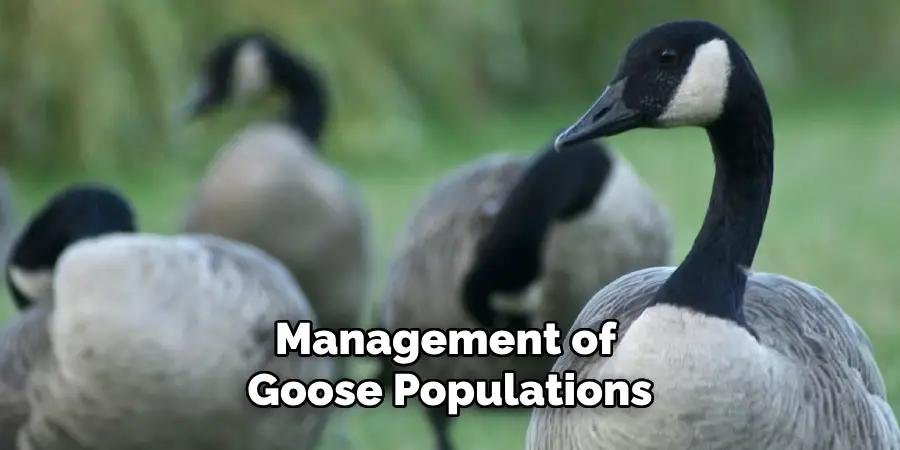
Frequently Asked Questions
Q1: Is a Permit Required for Goose Trapping?
A1: Yes, a permit is usually required for goose trapping, as it is regulated by local, state, and federal wildlife regulations. It’s essential to check with your local wildlife agency to understand the specific requirements for your area.
Q2: How Can I Ensure the Humane Treatment of Trapped Geese?
A2: Ensuring humane treatment involves providing adequate shelter and clean water and minimizing stress during capture and confinement. It’s also important to handle the geese gently to prevent injury.
Q3: Where Should I Release Captured Geese?
A3: Captured geese should be released in suitable habitats away from urban and developed areas, considering the needs of the geese and the potential impact on local ecosystems. Consult with a wildlife professional to find the most appropriate release sites.
Q4: Are There Effective Alternatives to Trapping for Managing Goose Populations?
A4: Yes, non-lethal deterrents such as habitat modification, visual and auditory deterrents, and repellents can effectively manage goose populations. Engaging professional assistance can also provide tailored strategies that suit your community’s needs.
Q5: How Can I Contribute to Humane Goose Management in My Community?
A5: Engaging with community collaboration efforts, attending educational programs, and volunteering for local wildlife management initiatives are great ways to contribute. Staying informed about humane practices and advocating for ethical wildlife management also plays a significant role.
Q6: Can Nuisance Goose Populations Pose Risks to Local Ecosystems?
A6: Yes, unchecked goose populations can lead to overgrazing, accumulation of droppings in public spaces, and potential conflicts with humans. Managing populations helps maintain balanced ecosystems and prevents these issues.
Conclusion
In summary, the humane trapping and managing goose populations require careful consideration, preparation, and respect for wildlife welfare. We’ve explored how to trap a goose ethically, emphasizing the need for proper equipment maintenance, adherence to wildlife regulations, and the humane treatment of captured geese. By implementing these methods and considering both current and alternative strategies, we ensure the effectiveness of our efforts while upholding ethical standards.
Responsible wildlife management practices cannot be overemphasized. They safeguard the well-being of both geese and human communities, prevent potential conflicts, and contribute to the health of our ecosystems. As we strive to coexist with our feathered neighbors, the principles discussed here guide communities worldwide.
We wish you success in managing goose populations and mitigating human-wildlife conflicts in your area. May your efforts be marked by compassion, lawfulness, and a deep respect for the natural world we share.

